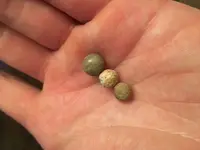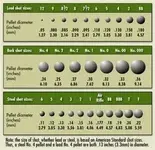You are using an out of date browser. It may not display this or other websites correctly.
You should upgrade or use an alternative browser.
You should upgrade or use an alternative browser.
Balls! (I finally have calipers)
- Thread starter thedukeofdelaware
- Start date
Icewing
Silver Member
- Joined
- Jan 5, 2016
- Messages
- 2,636
- Reaction score
- 5,517
- Golden Thread
- 0
- Location
- NW Arkanslaw
- Detector(s) used
- Minelab Equinox 900 / Garrett PropointerAT.
- Primary Interest:
- All Treasure Hunting
Upvote
0
If found on a colonial/Rev War site, then buckshot used for the early muskets. I found quite a few on Rev sites over the years.
Upvote
0
Icewing
Silver Member
- Joined
- Jan 5, 2016
- Messages
- 2,636
- Reaction score
- 5,517
- Golden Thread
- 0
- Location
- NW Arkanslaw
- Detector(s) used
- Minelab Equinox 900 / Garrett PropointerAT.
- Primary Interest:
- All Treasure Hunting
If found on a colonial/Rev War site, then buckshot used for the early muskets. I found quite a few on Rev sites over the years.
Modern shotguns still shoot buckshot, and to say it can't be modern just because the location has history would be irresponsible. The ball on the left has almost no oxidation, therefore it's highly unlikely that it's from the revolutionary war. [Just my opinion.]
But to be fair, I'd put it in my display case anyway, because I don't care, what's cool is cool.
Last edited:
Upvote
0
TheCannonballGuy
Gold Member
- Joined
- Feb 24, 2006
- Messages
- 6,607
- Reaction score
- 13,455
- Golden Thread
- 0
- Location
- Occupied CSA (Richmond VA)
- Detector(s) used
- White's 6000, Nautilus DMC-1, Minelab
- Primary Interest:
- Relic Hunting
Just some friendly advice about doing precise measuring of bullets/balls:
When measuring excavated lead bullets or balls, we must take the lead-oxide encrustation ("patina") thickness into account. (Remember, you are measuring two layers of it, one layer on each side of the bullet (or ball). Fairly thin patina can add .005-inch, "moderate" patina adds about .01-inch, and heavy patina can add as much as .02-inch the bullet/ball's original diameter. That is why some excavated civil war bullets measure .585-inch, which wouldn't fit down the barrel of a .58-caliber rifle. (By the way, there was no .59-caliber rifle.)
The two smaller balls in the photo show heavy lead-oxide patina. I'd subtract .02-inch from the measurement you got.
When measuring a fired cylindrical bullet (for rifles and pistols), we must take into account the thickness of the rifling-ridges made by the rifling-grooves in the gunbarrel, if the fired bullet shows them. Rifling-ridges can add as much as .02 to .03-inch to a bullet's original diameter.
Also, it's helpful to measure the ball in more than one direction, to detect whether it is out-of-round. If there's more than a VERY slight difference in the measurments you get, the ball is out-of-round and therefore is very unlikely to be a musketball/pistolball. Like cannonballs, those projectiles were very carefullly manufactured to be perfectly round, so they wouldn't jam inside the gunbarrel during loading or firing.
When measuring excavated lead bullets or balls, we must take the lead-oxide encrustation ("patina") thickness into account. (Remember, you are measuring two layers of it, one layer on each side of the bullet (or ball). Fairly thin patina can add .005-inch, "moderate" patina adds about .01-inch, and heavy patina can add as much as .02-inch the bullet/ball's original diameter. That is why some excavated civil war bullets measure .585-inch, which wouldn't fit down the barrel of a .58-caliber rifle. (By the way, there was no .59-caliber rifle.)
The two smaller balls in the photo show heavy lead-oxide patina. I'd subtract .02-inch from the measurement you got.
When measuring a fired cylindrical bullet (for rifles and pistols), we must take into account the thickness of the rifling-ridges made by the rifling-grooves in the gunbarrel, if the fired bullet shows them. Rifling-ridges can add as much as .02 to .03-inch to a bullet's original diameter.
Also, it's helpful to measure the ball in more than one direction, to detect whether it is out-of-round. If there's more than a VERY slight difference in the measurments you get, the ball is out-of-round and therefore is very unlikely to be a musketball/pistolball. Like cannonballs, those projectiles were very carefullly manufactured to be perfectly round, so they wouldn't jam inside the gunbarrel during loading or firing.
Last edited:
Upvote
0
l.cutler
Silver Member
.39 is definitely not a revolutionary era musketball. The smallest musketball would be in the .65 neighborhood. As well as buckshot it could also be a small rifle ball but one in that caliber would most likely be from a later period, likely from the first half of the 19th century.
Upvote
0
Similar threads
- Replies
- 8
- Views
- 555
- Replies
- 11
- Views
- 714
- Question
- Replies
- 2
- Views
- 524
Users who are viewing this thread
Total: 1 (members: 0, guests: 1)





